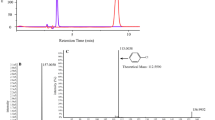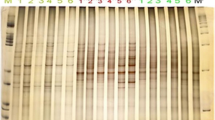Abstract
Four strains of biphenyl-degrading bacteria were isolated from a sewage and identified from the Rhodococcus genus (SK-1, SK-3, and SK-4) and Aquamicrobium genus (SK-2) by 16S rRNA sequence. Among these strains, strain SK-2 was most suitable for biphenyl degradation. When 0.65, 1.3, 2.6, or 3.9 mM of biphenyl was used, the biphenyl was completely degraded within 24 and 96 h of culture, respectively. However, in the case of 6.5 and 9.75 mM of biphenyl, the biphenyl degradation yields were about 80 % and 46.7 % after 120 h of culture, respectively. The isolated strains could degrade a broad spectrum of aromatic compounds including high-chlorinated polychlorinated biphenyl (PCB) congeners in the presence of biphenyl. In addition, strain SK-2 could utilize PCB congeners containing one to six chlorine substituents such as 2,2′,4,4′,5,5′-hexachlorobiphenyl. The PCB utilization rate by the strain SK-2 was increased compared to that of other PCB congener-utilizing bacteria. The four isolates metabolized 4-chlorobiphenyl to 4-chlorobenzoic acid and 2-hydroxy-6-oxo-6-(4′-chlorophenyl)-hexa-2,4-dienoic acid. These results suggest the isolated strains might be good candidates for the bioremediation of PCB-contaminated soil, especially high-saline soils.






Similar content being viewed by others
References
Pieper, D. H. (2005). Aerobic degradation of polychlorinated biphenyls. Applied Microbiology and Biotechnology, 67, 170–191.
Takashi, H., Mitsuhiro, W., & Kenichiro, N. (2008). Concentration and characteristics of polychlorinated biphenyls in the sediments of sea and river in Nagasaki Prefecture. Japan Journal of Health Science, 54, 400–408.
Hiroki, M. (2012). Current situation and issues of the industrial waste governance. Journal of Environmental Conservation Engineering, 41, 33–38.
Liu, W. X., Chen, J. L., Hu, J., Ling, X., & Tao, S. (2008). Multi-residues of organic pollutants in surface sediments from littoral areas of the Yellow Sea. Chinese Marine Pollution Bulletin, 56, 1091–1103.
Furukawa, K., & Matsumura, F. (1976). Microbial metabolism of polychlorinated biphenyls-studies on relative degradability of polychlorinated biphenyl components by Alcaligenes sp. Journal of Agricultural and Food Chemistry, 24, 251–256.
Unterman, R., Bedard, D. L., Brennan, M. J., Bopp, L. H., Mondello, F. J., Books, R. E., et al. (1988). Environmental biotechnology: reducing risks from environmental chemicals through biotechnology (pp. 253–269). New York: Plenum Press.
Hatamian-Zarmi, A., Shojaosadati, S. A., Vasheghani-Farahani, E., Hosseinkhani, S., & Emamzadeh, A. (2009). Extensive biodegradation of highly chlorinated biphenyl and Aroclor 1242 by Pseudomonas aeruginosa TMU56 isolated from contaminated soils. International Biodeterioration & Biodegradation, 63, 788–794.
Abdughafurovich, R. B., Andreevich, K. A., Lorenz Adrian, L., & Tashpulatovich, Y. K. (2010). Biodegradation of tritium labeled polychlorinated biphenyls (PCBs) by local salt tolerant mesophylic Bacillus Strains. Journal of Environmental Protection, 1, 420–425.
Wittich, R. M., & Wolff, P. (2007). Growth of the genetically engineered strain Cupriavidus necator RW112 with chlorobenzoates and technical chlorobiphenyls. Microbiology, 153, 186–195.
Kargi, F., & Dincer, A. R. (1999). Salt inhibition of nitrification and denitrification in saline wastewater. Environmental Technology, 20, 1147–1153.
Abramowicz, D. A. (1990). Aerobic and anaerobic biodegradation of PCBs. Critical Reviews in Biotechnology, 10, 241–251.
Jaysankar, D., Ramaiah, N., & Sarkar, A. (2006). Aerobic degradation of highly chlorinated polychlorobiphenyls by a marine bacterium, Pseudomonas CH07. World Journal of Microbiology and Biotechnology, 22, 1321–1327.
Davidova, I., Hicks, M. S., Fedorak, P. M., & Suflita, J. M. (2001). The influence of nitrate on microbial processes in oil industry production waters. Journal of Industrial Microbiology and Biotechnology, 27, 80–86.
Russo, R. C. (1985). Ammonia, nitrite and nitrate. In G. M. Rand & S. R. Petrocelli (Eds.), Fundamentals of aquatic toxicology (pp. 455–471). Washington DC, USA: Hemisphere Publishing Corporation.
Kim, P. J., Chang, K. W., & Min, K. H. (1995). Evaluation of the stability of compost made from food wastes by the fermenting tank. Journal of KOWREC, 3, 35–42.
Chang, Y. C., Ikeutsu, K., Toyama, T., Choi, D. B., & Kikuchi, S. (2011). Isolation and characterization of tetrachloroethylene and cis-1,2-dichloroethylene-dechlorinating propionibacteria. Journal of Industrial Microbiology and Biotechnology, 38, 1667–1677.
Martínková, L., Uhnáková, B., Pátek, M., Nešvera, J., & Křen, V. (2009). Biodegradation potential of the genus Rhodococcus. Environment International, 35, 162–177.
Yam, K. C., Van der Geize, R., & Eltis, L. D. (2010). Catabolism of aromatic compounds and steroids by Rhodococcus. Microbiology Monographs, 16, 133–169.
Nozaki, M., Kagamitama, H., & Hayaishi, O. (1963). Metapyrocatechase. I. Purification, crystallization and some properties. Biochem Z journal, 38, 582–590.
Furukawa, K., Simon, J. R., & Chakrabarty, A. M. (1983). Common induction and regulation of biphenyl, xylene/toluene, and salicylate catabolism in Pseudomonas paucimobilis. Journal of Bacteriology, 154, 1356–1362.
Furukawa, K., & Fujihara, H. (2008). Microbial degradation of polychlorinated biphenyls: biochemical and molecular features. Journal of Bioscience and Bioengineering, 105, 433–449.
Seto, M., Kimbara, K., Shimura, M., Hatta, T., Fukuda, M., & Yano, K. (1995). A novel transformation of polychlorinated biphenyls by Rhodococcus sp. strain RHA1. Applied and Environmental Microbiology, 61, 3353–3358.
Adebusoye, S. A., Picardal, F. W., Ilori, M. O., & Amund, O. O. (2008). Evidence of aerobic utilization of di-ortho-substituted trichlorobiphenyls as growth substrates by Pseudomonas sp. SA-6 and Ralstonia sp. SA-4. Environmental Microbiology, 10, 1165–1174.
Sakai, M., Ezaki, S., Suzuki, N., & Kurane, R. (2005). Isolation and characterization of a novel polychlorinated biphenyl-degrading bacterium, Paenibacillus sp. KBC101. Applied and Environmental Microbiology, 68, 111–116.
Kim, S. G., & Picardal, F. (2001). Microbial growth on dichlorobiphenyls chlorinated on both ring as a sole carbon and energy source. Applied and Environmental Microbiology, 67, 1953–1955.
Tu, C., Teng, Y., Luo, Y., Li, X., Sun, X., Li, Z., et al. (2011). Potential for biodegradation of polychlorinated biphenyls (PCBs) by Sinorhizobium meliloti. Journal of Hazardous Materials, 186, 1438–1444.
Ahmad, D., Sylvestre, M., Sondossi, M., & Massé, R. (1991). Bioconversion of 2-hydroxy-6-oxo-6-(4’-chlorophenyl) hexa-2,4-dienoic acid, the meta-cleavage product of 4-chlorobiphenyl. Journal of General Microbiology, 137, 1375–1385.
Massé, R., Messier, F., Ayotte, C., Lévesque, M. F., & Sylvestre, M. (1989). A comprehensive gas chromatographic/mass spectrometric analysis of 4-chlorobiphenyl bacterial degradation products. Biomedical & Environmental Mass Spectrometry, 18, 27–47.
Acknowledgments
This research was supported by a Research for Promoting Technological Seeds Grant (A) No. 01–044, from the Japanese Science and Technology agency.
Author information
Authors and Affiliations
Corresponding authors
Rights and permissions
About this article
Cite this article
Chang, YC., Takada, K., Choi, D. et al. Isolation of Biphenyl and Polychlorinated Biphenyl-Degrading Bacteria and Their Degradation Pathway. Appl Biochem Biotechnol 170, 381–398 (2013). https://doi.org/10.1007/s12010-013-0191-5
Received:
Accepted:
Published:
Issue Date:
DOI: https://doi.org/10.1007/s12010-013-0191-5




